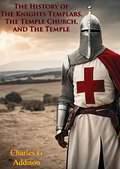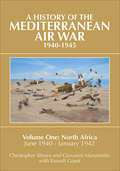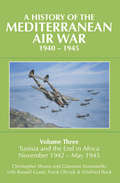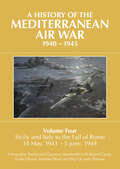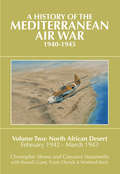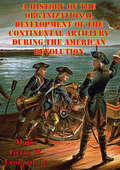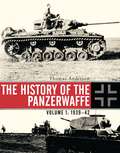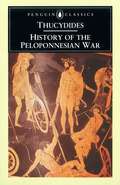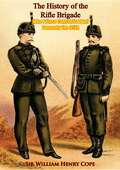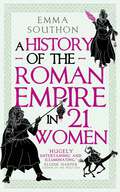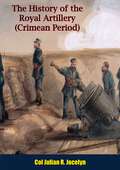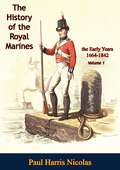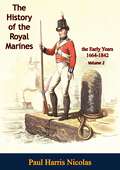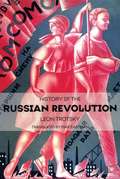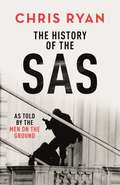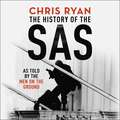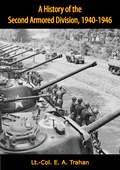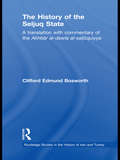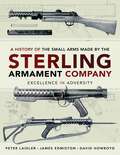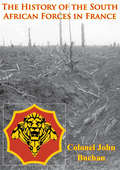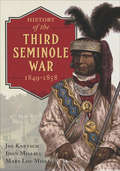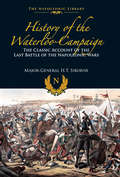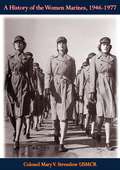- Table View
- List View
The History of The Knights Templars, The Temple Church, and The Temple: Large Print
by Charles G Addison“The warrior knights of the crossThe Knights Templar were one of the most famous Christian military orders of the medieval period. Officially endorsed by the church in the early decades of the 12th century the express purpose of the order was to provide defence and protection to Christian pilgrims. The concept became a popular one and with patronage came wealth and power so that the order, through a substantial infrastructure of non-warrior members spread throughout Europe promoting its objectives, developing financial institutions and building fortification on a grand scale. However, the Knights Templar are especially remembered today for the prowess of their military knights. Clad in white mantles bearing the distinctive red cross the Templars both attracted and created some of the most expert and effective fighting men of their time. Naturally, the order was closely connected to the Holy Land and with the Crusades. For some two hundred years it fought the forces of Islam for dominance of Jerusalem experiencing mixed fortunes in dozens of actions and major battles. The eventual loss of the Holy Land could do no other than promote a decline in their fortunes, and indeed, the support for the Templars. Furthermore, the order's wealth and its independent structure, wielding power outside state and church, inevitably made it a target for both suspicion and dissolution. The end came in 1312—in a welter of torture, bloodshed and burnings at the stake. The legend has lived on however, and today the times of Knights Templar are to many more intriguing and evocative than ever.”-Print ed.
A History of the Mediterranean Air War, 1940–1945: North Africa
by Russell Guest Giovanni Massimello Christopher ShoresThis first volume in the seminal series on World War II aerial combat, pilots, and tactics that “reads like an encyclopedia on the subject” (Portland Book Review). In the early days of World War II, both Allied and Axis powers extended the theater of war to North Africa, where hard-fought battles were conducted in the harsh desert. But before anyone could claim victory on the ground, they had to hold dominion in the air. Here, historian Christopher Shores has combined his books Fighters over the Desert and Fighters over Tunisia into one volume, as well as adding updated information about the deadly fighter aircraft, reconnaissance aircraft, and maritime units active in the Mediterranean. Full of in-depth research and featuring essential maps, this is “an intimate introspection by these men of their experiences and the respect that they shared not only for each other but also their adversaries” (The Military Reviewer).
A History of the Mediterranean Air War, 1940–1945: Tunisia and the End in Africa, November 1942–1943 (A\history Of The Mediterranean Air War, 1940-1945 Ser. #2)
by Giovanni Massimello Christopher Shores Russell Guest Frank OlynykThe third volume in the epic military aviation series focuses on the Allied invasion of North Africa during World War II. This work of WWII history takes us to November 1942 to explain the background of the first major Anglo-American venture: Operation Torch, the invasion of French North Africa. Describing the fratricidal combat that followed the initial landings in Morocco and Algeria, it then considers the unsuccessful efforts to reach northern Tunisia before the Germans and Italians could get there to forestall the possibility of an attack from the west on the rear of the Afrika Korps forces, then beginning their retreat from El Alamein. The six months of hard fighting that followed, as the Allies built up the strength of their joint air forces and gradually wrested control of the skies from the Axis, are recounted in detail. The continuing story of the Western Desert Air Force is told, as it advanced from the east to join hands with the units in the west. Also covered are the arrivals over the front of American pilots and crew, the P-38 Lightning, the Spitfire IX, and the B-17 Flying Fortress—and of the much-feared Focke-Wulf Fw 190. The aerial activities over Tunisia became one of the focal turning points of World War II, yet are frequently overlooked by historians. Here, the air-sea activities, the reconnaissance flights, and the growing day and night bomber offensives are examined in detail.
A History of the Mediterranean Air War, 1940–1945: Sicily and Italy to the Fall of Rome 14 May, 1943–5 June, 1944
by Christopher Shores Giovanni Massimello Russell Guest Frank Olynyk Winfried Bock Commander Andy ThomasThe fourth volume in this momentous series commences with the attacks on the Italian island fortress of Pantellaria which led to its surrender and occupation achieved almost by air attack alone. The account continues with the ultimately successful, but at times very hard fought, invasions of Sicily and southern Italy as burgeoning Allied air power, now with full US involvement, increasingly dominated the skies overhead. The successive occupations of Sardinia and Corsica are also covered in detail. This volume, then, is essentially the story of the tactical air forces up to the point when Rome was occupied, just at the same time as the Normandy landings were occurring in north-west France. In its pages are found what can justifiably be considered the story of ‘the soldiers’ air force’. Frequently overlooked by more immediate newsworthy events elsewhere, their struggle was often of an equally Homeric nature. With regards to the long-range tactical role of the Allied heavy bombers, only the period from May to October is examined herein, while they remained based in North Africa. Thus the period from November 1943 when the US 15th Air Force was formed to pursue the strategic air offensive against the Reich, together with the RAF’s 205 Group of night bombers, will be covered in a future (sixth) volume. Volume Five will deal with the rest of the tactical war in Italy and Greece, over the Adriatic and Aegean, and with the entry into the South of France to join forces advancing southwards from Normandy.
A History of the Mediterranean Air War, 1940–1945. Volume 2: North African Desert, February 1942–March 1943
by Christopher Shores Giovanni Massimello Russell Guest Frank Olynyk Winfried BockThis second volume in the seminal series on aerial combat, pilots, and tactics in Libya and Egypt in the middle of World War II. In volume two of this series, historian Christopher Shores begins by exploring the 8th Army&’s movements after Operation Crusader when they were forced back to the Gazala area in northeastern Libya, as well as their defeat in June, 1942, the loss of Tobruk, and the efforts of Allied air forces to protect their retreating troops. Shores continues with the heavy fighting that followed in the El Alamein region. This features the Western Desert Air Force and the arrival of the first Spitfires. The buildup of both army and air forces and the addition of new commanders on the ground aided the defeat of Rommel&’s Deutsche Afrika Korps at Alam el Halfa, after which came the Second Battle of El Alamein. With the arrival of the United States Army Air Force, the Allied air forces gained dominance over the Axis. Shores recounts the lengthy pursuit of the Italo-German forces right across Libya, including the capture of Tripoli and the breakthrough into Southern Tunisia. This allowed a linkup with other Allied forces in Tunisia (whose story appears in Volume 3). Included with the action are stories of some of the great fighter aces of the Desert campaign such as Jochen Marseille and Otto Schulz of the Luftwaffe, Franco Bordoni-Bisleri of the Regia Aeronautica and Neville Duke, Billy Drake, and &“Eddie&” Edwards of the Commonwealth air forces. Finally, Shores touches on the Allied and Axis night bombing offensives and the activities of the squadrons cooperating with the naval forces in the Mediterranean.
A History Of The Organizational Development Of The Continental Artillery During The American Revolution
by Major William C. Pruett US ArmyThe thesis of this study is that the Continental artillery in the American Revolution, despite its ad hoc beginning and wartime challenges, gradually developed into a professional organization by the end of the war. Rather than operational history of the organization, its focus is on the growth of the organization over time, in terms of its cultural beginnings, its doctrinal development, and the leadership and career paths of some of its middle ranking leaders. The first chapter lays out the structural framework and statutory authorizations for the organization. The second chapter describes its early cultural shift from its pre-war legacy of provincialism to a trajectory toward professionalism. This chapter uses a cultural analysis to argue that Washington's decision to replace the aged Richard Gridley with Henry Knox as the commander of the Continental artillery ushered in a cultural shift away from an older provincial organizational culture to one that sought professionalism. The third chapter portrays the development of a battlefield tactical doctrine described in books that gradually took hold in informal ways. It takes a comparative theory and practice approach to argue that the kernel of an emerging doctrine existed in available European books and from those kernels, a consistent and effective doctrine developed over time. The fourth chapter uses a collective biographical approach to show organizational development in the careers of its middle ranking leaders. The concluding chapter summarizes findings and ties the professionalization of the corps of artillery to the military establishments of the new republic.
The History of the Panzerwaffe Volume I: 1939-1942
by Thomas AndersonThis is the definitive history of the evolution of the feared German Panzerwaffe, from its earliest beginings to the height of its success. With rare and revealing combat reports and photographs sourced from previously unseen private and archival collections, it uncovers the technical and operational stories of the formidable armored beasts that formed the backbone of the German war machine--tanks such as the Panzer I, II and 38(t).The Germans transformed armored warfare from a lumbering and ponderous experiment in World War I, into something that could decide the outcome of conflicts. This technical and operational history is the definitive guide to the legendary Panzerwaffe, from its very infancy to the days when it made Europe its garden path at the height of Nazi German power.
History of the Peloponnesian War
by Thucydides'With icy remorselessness, it puts paid to any notion that the horrors of modern history might be an aberration - for it tells of universal war, of terrorism, revolution and genocide' Tom HollandThe long life-and-death struggle between Athens and Sparta plunged the ancient Greek world into decades of war. Thucydides was an Athenian and achieved the rank of general in the earlier stages of the war, and in this detailed, first-hand contemporary account he writes as both a soldier and a historian. He applies a passion for accuracy and a contempt for myth and romance in compiling a factual record of a ruinous conflict that would eventually destroy the Athenian empire.Translated by Rex Warner with an introduction and notes by M. I. Finley
The History of the Rifle Brigade (The Prince Consort’s Own) Formerly the 95th: Formerly The 95th (1877)
by Sir William Henry CopeIn this book, originally published in 1877, late lieutenant William Henry Cope recounts the trials and tribulations of the Rifle Brigade (The Prince Consort’s Own) in which he served. An infantry rifle regiment of the British Army that was formed in Jan. 1800 as the “Experimental Corps of Riflemen” to provide sharpshooters, scouts and skirmishers (soon renamed the “Rifle Corps”). In 1816, at the end of the Napoleonic Wars, they were again renamed, this time as the “Rifle Brigade”. The unit was distinguished by its use of green uniforms as standard in place of the traditional redcoat, as well as being armed with the first British-made rifle accepted by the British Army, in place of smoothbore muskets. Cope carries his narrative on through the Crimean War, the Indian Mutiny and postings to the far-flung corners of the British Empire to 1870.Richly illustrated throughout with maps and plans.“A WISH had long been entertained and often expressed by Riflemen, both by those serving in the Regiment and by those who had formerly served in it, that a detailed record of its services should be compiled... “To some readers some of the facts and anecdotes I have here recorded may appear trifling and unworthy of mention. But it must be borne in mind that I write for Riflemen, at the desire of Riflemen, and to preserve the memory of the deeds of Riflemen. By them I am sure nothing will be considered trivial, nothing out of place in a history of the Regiment, which records the valour, the acts, the sufferings or even preserves an anecdote of any (of whatever rank) of the members of that brotherhood.”-The Author
A History of the Roman Empire in 21 Women
by Emma SouthonRome as you&’ve never seen it before – brazenly unconventional, badly behaved and ever so feminine. &‘Hugely entertaining and illuminating&’ —Elodie Harper, author of The Wolf Den A WATERSTONES BEST HISTORY BOOK OF 2023 Here&’s how the history of the Roman Empire usually goes… We kick off with Romulus murdering his brother, go on to Brutus overthrowing Tarquin, bounce through an appallingly tedious list of battles and generals and consuls, before emerging into the political stab-fest of the late Republic. After &‘Et tu, Brute?&’, it runs through all the emperors, occasionally nodding to a wife or mother to show how bad things get when women won&’t do as they&’re told, until Constantine invents Christianity only for Attila the Hun to come and ruin everything. Let&’s tear up this script. The history of Rome and its empire is so much more than these &‘Important Things&’. In this alternative history, Emma Southon tells another story about the Romans, one that lives through Vestal Virgins and sex workers, business owners and poets, empresses and saints. Discover how entrepreneurial sex worker Hispala Faecenia uncovered a conspiracy of treason, human sacrifice and Bacchic orgies so wild they would make Donna Tartt blush, becoming one of Rome&’s unlikeliest heroes. Book yourself a table the House of Julia Felix and get to know Pompeii&’s savviest businesswoman and restauranteur. Indulge in an array of locally sourced delicacies as you take in the wonderful view of Mount Vesuvius… what could possibly go wrong? Join the inimitable Septimia Zenobia, who – after watching a series of incompetent, psychopathic and incompetently psychopathic emperors almost destroy the Empire – did what any of us would do. She declared herself Empress, took over half the Roman Empire and ran it herself.
The History of the Royal Artillery (Crimean Period)
by Col. Julian R. JocelynFrom the doomed attempt to seize the Russian guns by the Light Brigade at Balaclava, to the Siege of Sebastopol itself, artillery played a major part in the Crimean War. This official history of the Royal Artillery Regiment in the conflict is therefore indispensable to a full picture of the war. Colonel Jocelyn's detailed account of operations opens with a description of the Regiment's organisation on the eve of the war, and discusses the changes brought about by the experience. Part II of the book deals with the military operations themselves, opening with the Battle of the Alma, the start of the protracted Siege of Sebastopol, the chaotic Battle of Balaclava and the bloody Battle of Inkerman. Although an official history, the author is unsparing in his criticism of errors when they occur. Each section of the book is accompanied by appendixes listing the forces, guns and officers present at each encounter. In addition there are 71 tables, 41 engravings, and ten maps."...Essential reading for a general view of the war as well as the details of the key part played by the artillery" Major Colin Robins-Print ed.
The History of the Royal Marines: The Early Years 1664-1842: Volume 1 (The History of the Royal Marines: the Early Years 1664-1842 #1)
by Paul Harris Nicolas“The first volume of a two volume anniversary history of the early Royal Marines.The Royal Marines can trace their origins back to the formation of 'The Duke of York and Albany's Maritime Regiment of Foot' in 1664…The Royal Marines as we know them today were formed in 1755 and since that time they have distinguished themselves in many conflicts fought by the British to the present day. Numerous books have been written about the exploits of the Royal Marines, particularly in the 20th century, but this special two volume edition concentrates on the earliest period of their history. The presence of red-coated marines was inseparable from the blue uniform of their naval comrades during the great age of sail and this book covers that period in detail including the American War of Independence. The great contest of the early 19th century was against Revolutionary, Consulate and Napoleon Bonaparte's First Empire of the French. The Royal Marines fought in every major naval engagement of that long war, all of which are detailed in these pages together with many minor engagements, the War of 1812 and the imperial campaigns including the Chinese Opium Wars.”-Print ed.
The History of the Royal Marines: The Early Years 1664-1842: Volume 2 (The History of the Royal Marines: the Early Years 1664-1842 #2)
by Paul Harris Nicolas“The first volume of a two volume anniversary history of the early Royal Marines.The Royal Marines can trace their origins back to the formation of 'The Duke of York and Albany's Maritime Regiment of Foot' in 1664…The Royal Marines as we know them today were formed in 1755 and since that time they have distinguished themselves in many conflicts fought by the British to the present day. Numerous books have been written about the exploits of the Royal Marines, particularly in the 20th century, but this special two volume edition concentrates on the earliest period of their history. The presence of red-coated marines was inseparable from the blue uniform of their naval comrades during the great age of sail and this book covers that period in detail including the American War of Independence. The great contest of the early 19th century was against Revolutionary, Consulate and Napoleon Bonaparte's First Empire of the French. The Royal Marines fought in every major naval engagement of that long war, all of which are detailed in these pages together with many minor engagements, the War of 1812 and the imperial campaigns including the Chinese Opium Wars.”-Print ed.
History of the Russian Revolution
by Leon Trotsky Max EastmanLeon Trotsky is considered by many, alongside Lenin of course, as the author of the Russian Revolution, and is also considered by his admirers to be one of the most astute Marxist analysts of history and politics. It is perhaps no surprise therefore that his history of the Russian Revolution, first published in English in 1932, should be considered by those admirers to be his masterpiece, with Afro-Trindidadian writer C.L.R. James, once calling it "the greatest history of an event that I know." Trotsky's narrative of the revolution is told in the third person and is not a memoir. Annotation ©2008 Book News, Inc., Portland, OR (booknews.com)
The History of the SAS
by Chris Ryan'Drawing on the stories of the soldiers who were there, this dramatic history of the SAS is full of bravado. Forged to fight guerrillas in the sweltering jungles of Malaya... Ryan writes with the authority of a man familiar with every nuance of the regiment's tactics, training, weapons and equipment.' - Sunday Times CultureTasked with storming mountain strongholds in the desert. Trained to hunt down the world's most wanted terrorists. This is the extraordinary story of 22 SAS. The history of the modern SAS is one of the great successes of post-war Britain. Since it was revived in 1950 to combat Communist insurgents, the Regiment has gone from strength to strength, fighting covert wars in Oman, Borneo, Northern Ireland, the Falklands, the Persian Gulf and beyond. In the process, it has become one of the most indispensable, and at times controversial, units in the British armyToday, the SAS is regarded as the world's leading Special Forces unit, renowned for its demanding Selection course and its relentless ability to adapt to the changing nature of warfare. More than anything else, however, it is the determination and ingenuity of the SAS soldiers that has made the Regiment what it is today. Drawing on his extensive network of contacts and his own experiences, Chris Ryan tells the story of the men on the ground. From the earliest patrols in the Malayan jungle, through to the storming of the Iranian Embassy, the daring raids behind enemy lines in the Gulf War, and up-to-minute missions to capture or kill notorious terrorists - this is the gripping, no-holds-barred account of Regiment operations. Above all, it is a story of elite soldiers fighting, and triumphing, against seemingly impossible odds.
The History of the SAS
by Chris Ryan'Drawing on the stories of the soldiers who were there, this dramatic history of the SAS is full of bravado. Forged to fight guerrillas in the sweltering jungles of Malaya... Ryan writes with the authority of a man familiar with every nuance of the regiment's tactics, training, weapons and equipment.' - Sunday Times CultureTasked with storming mountain strongholds in the desert. Trained to hunt down the world's most wanted terrorists. This is the extraordinary story of 22 SAS. The history of the modern SAS is one of the great successes of post-war Britain. Since it was revived in 1950 to combat Communist insurgents, the Regiment has gone from strength to strength, fighting covert wars in Oman, Borneo, Northern Ireland, the Falklands, the Persian Gulf and beyond. In the process, it has become one of the most indispensable, and at times controversial, units in the British armyToday, the SAS is regarded as the world's leading Special Forces unit, renowned for its demanding Selection course and its relentless ability to adapt to the changing nature of warfare. More than anything else, however, it is the determination and ingenuity of the SAS soldiers that has made the Regiment what it is today. Drawing on his extensive network of contacts and his own experiences, Chris Ryan tells the story of the men on the ground. From the earliest patrols in the Malayan jungle, through to the storming of the Iranian Embassy, the daring raids behind enemy lines in the Gulf War, and up-to-minute missions to capture or kill notorious terrorists - this is the gripping, no-holds-barred account of Regiment operations. Above all, it is a story of elite soldiers fighting, and triumphing, against seemingly impossible odds.
The History of the SAS: As told by the men on the ground
by Chris RyanForged to fight guerrillas in the sweltering jungles of Malaya.Tasked with storming mountain strongholds in the desert. Trained to hunt down the world's most wanted terrorists. This is the extraordinary story of 22 SAS. The history of the modern SAS is one of the great successes of post-war Britain. Since it was revived in 1950 to combat Communist insurgents, the Regiment has gone from strength to strength, fighting covert wars in Oman, Borneo, Northern Ireland, the Falklands, the Persian Gulf and beyond. In the process, it has become one of the most indispensable, and at times controversial, units in the British armyToday, the SAS is regarded as the world's leading Special Forces unit, renowned for its demanding Selection course and its relentless ability to adapt to the changing nature of warfare. More than anything else, however, it is the determination and ingenuity of the SAS soldiers that has made the Regiment what it is today. Drawing on his extensive network of contacts and his own experiences, Chris Ryan tells the story of the men on the ground. From the earliest patrols in the Malayan jungle, through to the storming of the Iranian Embassy, the daring raids behind enemy lines in the Gulf War, and up-to-minute missions to capture or kill notorious terrorists - this is the gripping, no-holds-barred account of Regiment operations. Above all, it is a story of elite soldiers fighting, and triumphing, against seemingly impossible odds.(P) 2019 Hodder & Stoughton Ltd
A History of the Second Armored Division, 1940-1946
by Lt.-Col. E. A. TrahanOriginally published in 1946, this book is an official unit history for the 2d Armored Division in World War II, which was activated on 15 July 1940 and participated in campaigns in Normandy, Northern France, Rhineland, Ardennes-Alsace, Central Europe, and Sicily.Elements of the Division first saw action in North Africa, landing at Casablanca in November 1942, and later took part in the fighting at Beja, Tunisia, but as a whole did not enter combat until the invasion of Sicily, when it made an assault landing at Gela in July 1943 and saw action at Butera, Campobello, and Palermo.After the Sicilian campaign, the Division trained in England for the cross-Channel invasion, landed in Normandy D plus 3 on 9 June 1944, and went into action in the vicinity of Carentan. The Division raced across France in July and August, drove through Belgium, and attacked across the Albert Canal in September, crossing the German border at Schimmert to take up defensive positions near Geilenkirchen. In October, it launched an attack on the Siegfried Line from Marienberg, broke through, crossed the Wurm River, and seized Puffendorf and Barmen in November. It was holding positions on the Roer when it was ordered to help contain the German Ardennes offensive.The Division helped reduce the Bulge in January 1945, fighting in the Ardennes forest in deep snow, and cleared the area from Houffalize to the Ourthe River of the enemy. After a rest in February, the Division drove on across the Rhine in March, and was the first American Division to reach the Elbe at Schonebeck in April, where it was halted, on orders. In July 1945, the Division entered Berlin—the first American unit to enter the German capital city.Known as the "Hell on Wheels" division, the 2d Armored Division was one of the most famous American units in World War II.Richly illustrated throughout with photos of the 2d Armored Division, General George Patton, battle photographs and maps.
The History of the Seljuq State: A Translation with Commentary of the Akhbar al-dawla al-saljuqiyya (Routledge Studies in the History of Iran and Turkey)
by Clifford Edmund BosworthThe Akhbar al-dawla al-saljuqiyya is one of the key primary documents on the history of Western Persia and Iraq in the 11th and 12th centuries. This book provides an accessible English translation and commentary on the text, making available to a new readership this significant work on the pre-modern history of the Middle East and the Turkish peoples. The text is a chronicle of the Seljuq dynasty as it emerged within the Iranian lands in the 11th and 12th centuries, dominating the Middle Eastern lands, from Turkey and Syria to Iran and eastern Afghanistan. During this formative period in the central and eastern Islamic lands, they inaugurated a pattern of Turkish political and military dominance of the Middle East and beyond, from Egypt to India, in some cases well into the 20th century. Shedding light on many otherwise obscure aspects of the political history of the region, the book provides a more detailed context for the political history of the wider area. As such, it will be of great interest to scholars of Middle Eastern history and is an important addition to the existing literature on the Seljuq dynasty.
The History of the Shanghai Jews: New Pathways of Research (Palgrave Series in Asian German Studies)
by Kevin Ostoyich Yun XiaThis volume provides a historical narrative, historiographical reviews, and scholarly analyses by leading scholars throughout the world on the hitherto understudied topic of Shanghai Jewish refugees. Few among the general public know that during the Second World War, approximately 16,000 to 20,000 Jews fled the Nazis, found unexpected refuge in Shanghai, and established a vibrant community there. Though most of them left Shanghai soon after the conclusion of the war in 1945, years of sojourning among the Chinese and surviving under the Japanese occupation generated unique memories about the Second World War, lasting goodwill between the Chinese and Jews, and contested interpretations of this complex past. The volume makes two major contributions to the studies of Shanghai Jewish refugees. First, it reviews the present state of the historiography on this subject and critically assesses the ways in which the history is being researched and commemorated in China. Second, it compiles scholarship produced by renowned scholars, who aim to rescue the history from isolated perspectives and look into the interaction between Jews, Chinese, and Japanese.
A History of the Small Arms Made by the Sterling Armament Company: Excellence in Adversity
by Peter Laidler James Edmiston David HowroydAn in-depth history of the small arms made by the Sterling Company of Dagenham, Essex, England, from 1940 until the company closed in 1989.The Lanchester and the Patchett Machine Carbines were both developed at Sterling Engineering Co Ltd during World War II.With the appearance of the earliest Patchett prototypes the military began testing them in ever more rigorous trials, wherein the Patchett kept proving its merits. This led to limited UK adoption of the MkII Patchett as the L2A1 in 1953, and the “first Sterling,” the MkII, as the L2A2 in 1955.Then came Sterling’s “Crown Jewel,” the superb Mk4, adopted as the general-issue UK “Gun, Sub-Machine, L2A3” in September, 1955. Manufactured briefly but intensively by ROF Fazakerley (1955–1959) and by Sterling for over 30 years, nearly 4,000,000 were made.Unlike wraparound bolt designs like the UZI, the Sterling was capable of being truly silenced with standard 9mm ball ammunition (as opposed to being merely “suppressed”). The excellent silenced Sterling-Patchett Mk5, adopted as the UK L34A1 in 1967, is the only Sterling remaining in British Service.All prototypes, military Marks, commercial and licensed production models of the Sterling are described, including the Canadian C1 SMG and the Indian 1A Carbine. Contains notes on manufacturing methods and procedures as used at Sterling, ROF Fazakerley, Canadian Arsenals Limited and the Indian Small Arms Factory, Kanpur (Cawnpore), plus extensive notes on inter-model interchangeability, serial number ranges, quantities produced, client-country purchases of the various Sterling Marks, and accessories.Praise for A History of the Small Arms made by the Sterling Armament Company“If you have an interest in small arms then this is a book that belongs in your library or book shelf. The book does a great job of providing the reader with the story of the weapons that evolved into the Sterling sub-machine gun and the changes in design that took place over that history. The result was a weapon that served in many fields of conflict and performed admirably.” —Armorama
The History Of The South African Forces In France [Illustrated Edition]
by Colonel John BuchanIncludes 22 maps and 18 illustrationsTens of thousands of men came from all round the Empire to aid the British war effort in the First World War; men from Australia, New Zealand, Canada, India and South Africa fought and died on battlefields far away from their homes. Although these soldiers fought across many different countries for the Allied cause; each of the Nations is linked with a single battle or campaign in which their sacrifice stood out even in the horrific bloodshed of the First World War. For the South Africans it was the heroic, bloody struggle for Delville wood during the battle of the Somme; during which they held their ground under a furious counter assault by the Germans, the South African 1st Brigade suffered 80% casualties in that action alone. Basil Liddell Hart called this engagement "...the bloodiest battle hell of 1916."However as the esteemed author and soldier, Colonel John Buchan points out in his introduction to this classic Official History, the South Africans fought with equal bravery and distinction wherever and whenever they took to the field. As he states his book "...is a tale to be proud of, for among the many brigades in that field the South African Infantry Brigade may be said, without boasting, to have had no superior and not many equals."A fitting tribute to the many brave South African soldiers who fought and conquered during the First World War written by an acclaimed author.
History of the Third Seminole War: 1849-1858
by Joe Knetsch John Missall Mary Lou MissallThis definitive account of the final war between the US government and Florida’s Seminole tribe “brings to life a conflict that is largely ignored” (San Francisco Book Review).Spanning a period of over forty years (1817-1858), the three Seminole Wars were America’s longest, costliest, and deadliest Indian wars, surpassing the more famous ones fought in the West. After an uneasy peace following the conclusion of the second Seminole War in 1842, a series of hostile events, followed by a string of murders in 1849 and 1850, made confrontation inevitable. The war was also known as the “Billy Bowlegs War” because Billy Bowlegs, Holata Micco, was the central Seminole leader in this the last Indian war to be fought east of the Mississippi River. Pushed by increasing encroachment into their territory, he led a raid near Fort Myers. A series of violent skirmishes ensued. The vastness of the Floridian wilderness and the difficulties of the terrain and climate caused problems for the army, but they had learned lessons from the second war, and, amongst other new tactics, employed greater use of boats, eventually securing victory by cutting off food supplies.History of the Third Seminole War is a detailed narrative of the war and its causes, containing numerous firsthand accounts from participants in the conflict, derived from virtually all the available primary sources, collected over many years. “Any reader interested in learning more about Indian wars, Army history, or Florida history will profit from reading this book,” as well as Civil War enthusiasts, since many of the officers earned their stripes in the earlier conflict (The Journal of America’s Military Past).
The History of the Waterloo Campaign: The Classic Account of the Last Battle of the Napoleonic Wars
by H.T. SiborneCaptain William Siborne became an ensign in the 9th Foot in 1813 and was sent to France in 1815 as part of a battalion despatched to reinforce Wellingtons army. A notable topographer, after the events that year he was commissioned to create a scale model of the Battle of Waterloo, for which he carried out extensive research, writing to officers in the allied forces present to obtain information. The subsequent correspondence amounted to the largest single collection of primary source material on the subject ever assembled. After he had completed his model, which is today on public display in the National Army Museum in London, he used the mass of information he had gathered to produce his History of the Waterloo Campaign, which was at the time the most detailed account of the operations of 1815 and is still considered a classic work on the subject.Sibornes history of Waterloo, the latest addition to Frontline's growing Napoleonic Library, is essential and gripping reading for all those who are interested in how this famous battle was fought and won.
A History of the Women Marines, 1946-1977
by Colonel Mary V. Stremlow USMCRProvides a historical review of women in the Marine Corps from their reservist status in 1946 through active status in 1977. Based upon original research. Illustrated.
